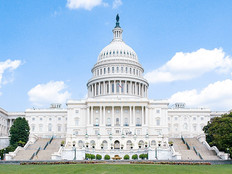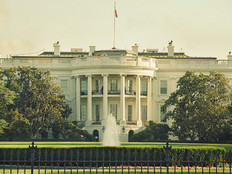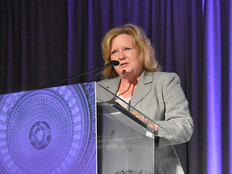White House Sees IT Modernization as a Relay Race, Not a Sprint or Marathon
The Trump administration thinks the best way forward to modernize government technology and deliver the kind of services the American people expect is to bring together government officials who normally do not work with one another.
Matt Lira, special assistant to the president for innovation policy and initiatives, said that, amid a hyperpartisan political environment, there has historically been bipartisan agreement on the idea of leveraging technology to modernize the government. Speaking June 15 at the FedScoop Digital Nation Summit in Washington, D.C., Lira said that effort “is something that this administration is striving strenuously to continue.”
Lira is a key member of the Office of American Innovation, which President Donald Trump announced in late March to make recommendations to him on policies and plans that improve government operations and services, enhance the quality of life for Americans and spur job creation. The OAI has been holding weekly meetings with key stakeholders in government, the private sector, the nonprofit world and academia, Lira said.
“We’re seeing a really exciting collaboration between people who don’t always agree, but they are able to come together to work on these problems,” Lira said. “And in fact, frankly, their conversations are that much stronger not in spite of those differences, but because of them. So it’s in the best American tradition that we work on these issues together.”
SIGN UP: Get more news from the FedTech newsletter in your inbox every two weeks!
The White House’s Approach to IT Modernization
The White House wants to take a collaborative approach to updating government technology and processes, Lira said.
“We view modernizing government not as really a sprint or a marathon, but as a relay race,” he said. “Because even if we were able to wave a magic wand and truly modernize the government in an afternoon — which we of course can’t do — but even if we could do that, within six months we’d have to modernize something [again] because technology is always changing, technology is always innovating.
“The real way to tackle this problem is to bring people together, do some structural reforms, build great consensus in communities around the policymaking space and have those systems work on an ongoing basis to continually modernize government systems in light of technological changes,” Lira added.
Why is that so critical? Lira said there is often a disconnect between the policies that politicians and policymakers — at all levels of government — espouse and the “operational reality” of how those policies are implemented on the ground. Often, the policy — whether it’s the government’s cloud-first policy or a citizen-facing service — doesn’t match up with citizens’ expectations.
“And as this disconnect grows, driven in large part by disruptive technology, there’s really a risk of rising frustration for the American people,” Lira said, “because they’re saying, ‘I voted for X, and I’m not experiencing X. Why is this happening?’”
The OAI is trying to tackle that frustration by convening private sector actors and government policymakers and employees, Lira said, who “are as frustrated by the operational barriers and the out-of-date manual, so to speak, as the American public is.”
A key goal of the meetings is to “connect these pockets of excellence, these amazing civil servants that exist throughout the federal government,” with private sector actors to develop new operational rules, get rid of out-of-date regulations and provide “political top cover” to help agencies achieve their mission for the American people, Lira said.
Weekly Meetings Spur Collaboration
The weekly OAI meetings, which Lira described as “very inclusive,” include representatives from the U.S. Digital Service and the General Services Administration’s 18F digital services unit. The meetings are aimed at “tearing down silos between all of these different stakeholders,” especially among agencies.
By talking to one another on an ongoing basis, Lira said, the meeting participants — which include officials from the office of the federal CIO and various agencies — “start to trust each other. And as that trust builds, it’s exciting to see the ability of that work to transform government itself.”
“They genuinely are collaborating, which is exciting to see,” Lira told reporters at the event.
“Some of these folks have never, frankly, talked to each other on an ongoing basis,” Lira added. “The most exciting thing for me is the connection of policymakers with engineers, so there’s a connection between policy and ground truth, which I think is really helpful for both.”
What are the OAI meetings tackling? Lira was tight-lipped but said it was a combination of “front-end citizen experiences and underlying policy.”
Many times when these groups convene, Lira said, “they want to hack around problems. I understand why that is. But we are also looking to hack at the problem itself. If there’s a process that’s broken and they have a great hack around it, that’s valuable information. But it’s also [necessary] to look at why the process itself is flawed.”
Fostering that collaborative culture is important, Lira said. “For people who have done this professionally for a decade-plus but have never met with their counterparts in another agency, once they get to know each other, they’re going to keep knowing each other and they’re going to keep working together and they’re going to keep trusting each other,” he said.
Could that lead to more shared services among agencies? “We don’t want to put the cart before the horse,” Lira said.
Ultimately, the federal IT community and private sector partners will be the ones sustaining that effort and moving things from “‘that was a great six-month project’ to a true, thoughtful transformation throughout the federal government,” Lira said.
“We’re very, very excited to work with all stakeholders. It’s a critical priority that this maintain itself as what it has been, in the previous administration and on [Capitol Hill], as a relatively apolitical area where we can just get the best minds together and work on this together in a collaborative way,” Lira said. “That is our approach as we move forward, and we’re tremendously excited about the opportunity.”
Beyond leading to more modern IT, Lira said, that approach has the potential to close “the gap between policy desire and operational reality, which will lessen the frustration of the American people, which will increase their faith in democracy and governance.”









